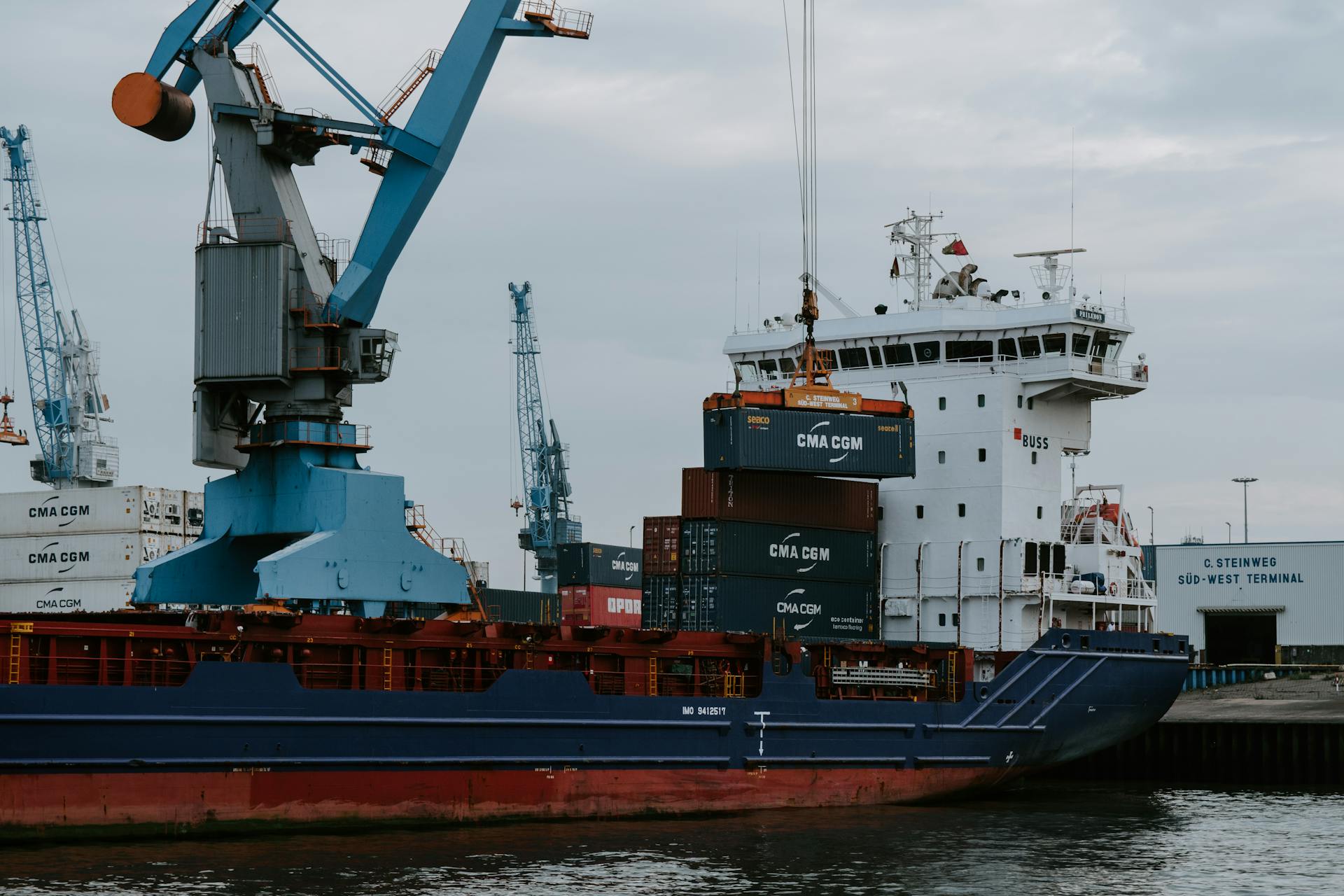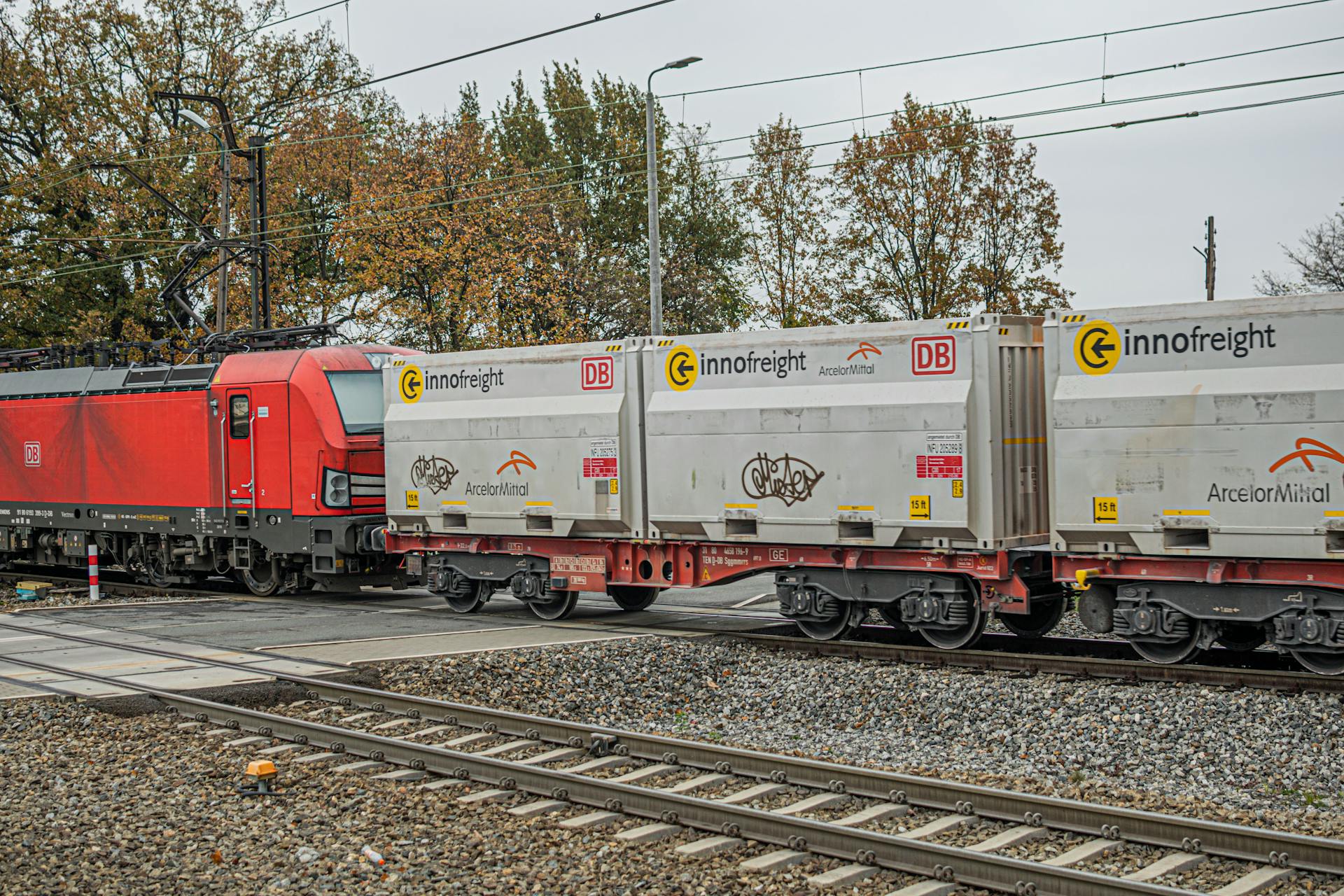
Cargo pallets come in a variety of types, including wood, plastic, and metal pallets.
Wood pallets are the most common type, accounting for over 90% of all pallets in use.
They can be made from different types of wood, such as hardwood or softwood, and are often treated with chemicals to prevent rot and insect damage.
Plastic pallets are a popular choice for companies looking for a more durable and low-maintenance option.
They are made from a variety of materials, including polypropylene and polyethylene, and can be recycled at the end of their life cycle.
Metal pallets are less common but offer a number of benefits, including strength and durability.
They are often used in heavy-duty applications, such as in the automotive and aerospace industries.
Innovations in cargo pallet design have led to the development of new types of pallets, such as collapsible pallets and pallets with built-in dividers.
These designs can help to reduce shipping costs and improve the efficiency of warehouse operations.
Types of Cargo Pallets

There are several types of cargo pallets, each designed for specific uses.
Standard pallets are the most common type, measuring 40 inches by 48 inches and weighing around 40 pounds when empty.
They come in different materials, including wood, plastic, and metal, with wood being the most traditional and widely used.
Wooden pallets are often preferred for their durability and cost-effectiveness.
Plastic pallets are made from high-density polyethylene and are resistant to moisture and pests, making them ideal for shipping food and pharmaceuticals.
Metal pallets are used for heavy loads and are often preferred for their strength and ease of cleaning.
Pallets can also be customized to fit specific cargo needs, such as oversized or irregularly shaped items.
The size and design of a pallet can greatly impact the efficiency of a shipping operation.
Specialized pallets, such as those with built-in dividers or tie-downs, can help prevent cargo damage and reduce shipping costs.
Pallets can also be designed to meet specific industry standards, such as those for the aerospace or automotive industries.
Design and Construction
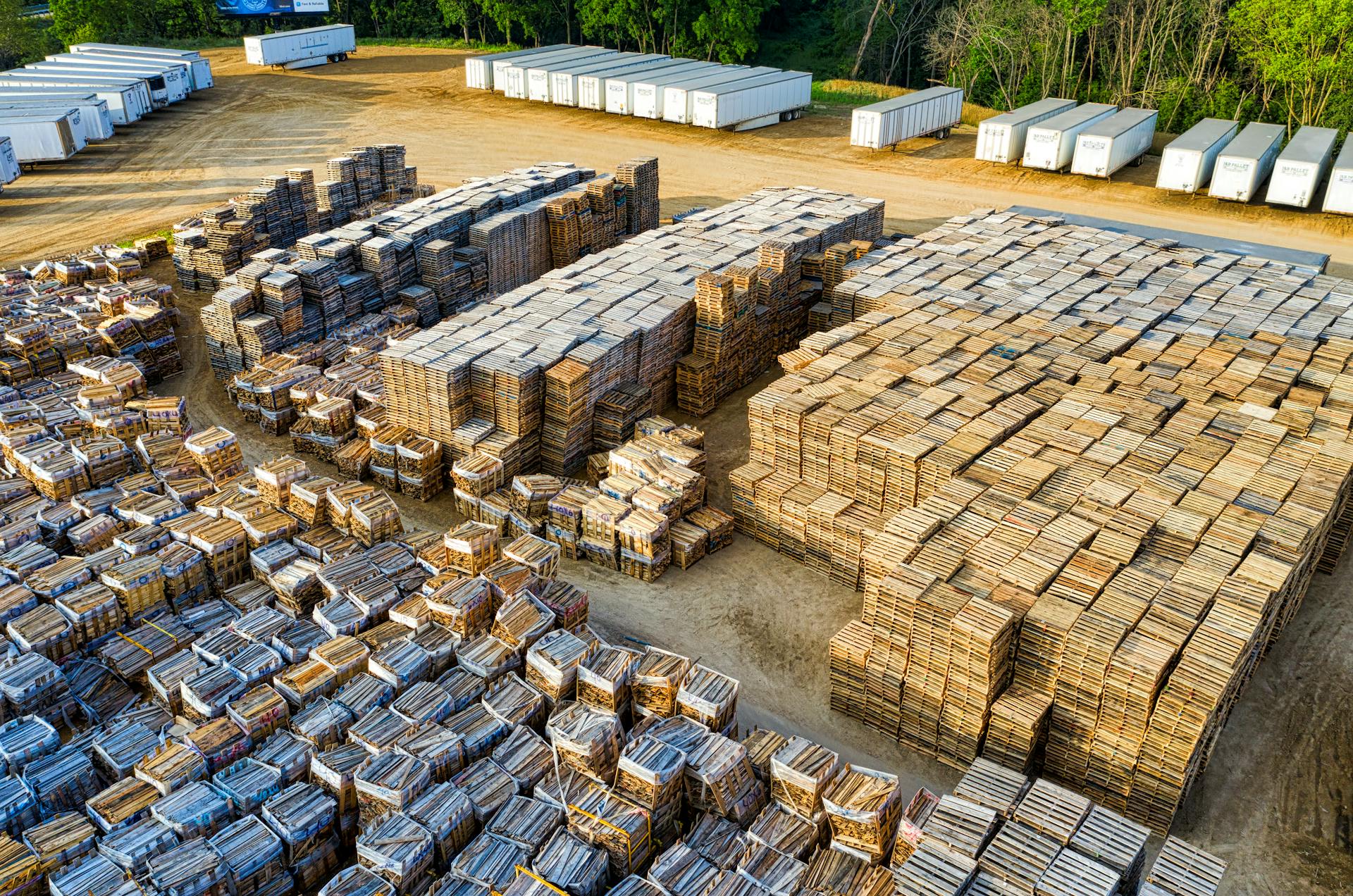
Wood pallets are the most commonly used pallet for freight-shipping purposes, making up the vast majority of pallet types used. They're inexpensive, easy to recycle/replace and have endless use cases.
The two most commonly used pallet designs to ship freight are block pallets and stringer pallets. Block pallets are distinguished by the blocks comprising their middle section, which bolsters the pallet's top section and allows it to support heavier freight.
Block pallets are most commonly made of wood, but this design is also found in some plastic pallets.
Common Designs Used
Block pallets are distinguished by the blocks comprising their middle section, which bolsters the pallet's top section and allows it to support heavier freight than other types of pallets.
Block pallets are commonly made from wood, but this design is also found in some plastic pallets. They're a popular choice for shipping heavy or oversized items.
Stringer pallets, on the other hand, are less common than block pallets, but still widely used in the shipping industry. They're known for their simple design and ease of use.
Discover more: B Pallets
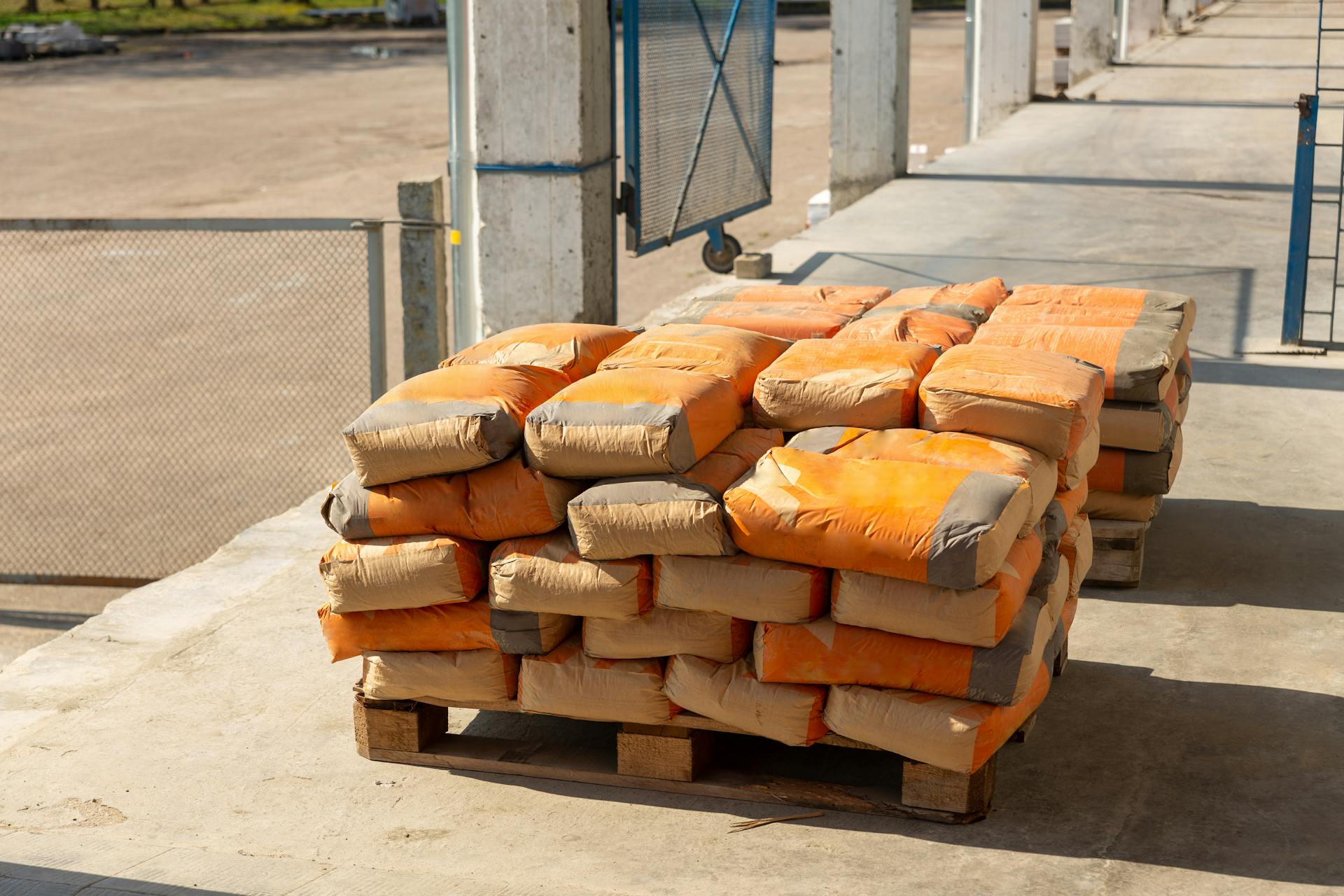
Here are some key differences between block and stringer pallets:
Both types of pallets have their own advantages and disadvantages, and the choice between them ultimately depends on the specific needs of the shipping operation.
Stringer
Stringer pallets are built with 2"X4" wood, plastic, or metal stringers that run between the top and bottom deck boards to add increased load support.
Stringer pallets can come in either a "two-way" or "four-way" design. Two-way pallets allow for forklifts to enter from two sides and are sometimes referred to as "unnotched." Four-way pallets allow forklifts to enter the pallet from any side.
Stringer pallets are most commonly found in the U.S. They can be made with various materials, including wood, plastic, or metal.
In the U.S., stringer pallets are a popular choice for many industries due to their versatility and load-carrying capacity.
Innovations in Design
Wood pallets made from hard and soft woods are the most commonly used pallet for freight-shipping purposes.

The two most commonly used pallet designs to ship freight are block pallets and stringer pallets.
Stringer pallets are built with 2"X4" wood, plastic, or metal stringers that run between the top and bottom deck boards to add increased load support.
These pallets can come in either a "two-way" or "four-way" design.
Here are the key differences between two-way and four-way pallets:
Modern technologies are influencing the development of air cargo pallet construction, introducing innovative materials and solutions.
Weight and Capacity
When selecting a cargo pallet, it's essential to consider its weight and capacity. A pallet's material and design can significantly impact its weight-bearing capacity.
For freight shipping purposes, a plastic pallet can safely carry up to 5,000 pounds, making it a great option for heavy loads. Steel pallets, on the other hand, can handle up to 4,000 pounds.
Here's a breakdown of the weight capacity for different types of pallets:
If you consistently ship heavy freight, consider switching to a steel pallet, as it will last longer than a wooden pallet.
Here's an interesting read: Which End of Pallet Industry Standard for Lifting Pallets
Weight
The weight of your pallet is a crucial factor in determining shipping costs. Having an accurate weight upfront will help keep your shipping costs in budget.
Pallet weight capacity varies depending on the design, construction, material, and size of your pallet. The type of pallet you use will also impact its weight capacity.
For freight shipping purposes, you can safely assume the following weight capacities for different types of pallets:
Consistently shipping heavier freight will determine the lifespan of your pallets. If you max out your pallets at 4,000 pounds, a steel pallet will last longer than a wooden pallet.
1-3000000, 1-3010000
In the realm of air cargo, slave pallets play a crucial role in the transportation of goods. They're designed to carry heavy loads, often weighing up to 30,000 kilograms.
Air cargo pallets are another essential component, allowing for efficient loading and unloading of cargo. These pallets come in various sizes to accommodate different types of goods.
If this caught your attention, see: Air Pallets
Air cargo containers are used to transport a wide range of items, from electronics to machinery. They're often equipped with specialized features such as climate control and ventilation.
The use of air cargo roller decks and ball decks allows for smooth and efficient movement of cargo. These decks can be easily loaded and unloaded, reducing handling time and increasing productivity.
Lifting platforms are used to load and unload heavy cargo from aircraft, ensuring safe and efficient handling. Airport scanners are also used to inspect cargo, providing an additional layer of security.
Here's a list of some common air cargo equipment, along with their typical weight capacities:
Aviation and Shipping
In the aviation and shipping industries, cargo pallets play a crucial role in the efficient transportation of goods. They help to ensure that products reach their destinations safely and on time.
The International Air Transport Association (IATA) regulates the use of cargo pallets in the aviation industry. This includes standards for pallet size, weight, and labeling.
Most cargo pallets are made from wood or plastic, with wood being the most common material. This is because wood pallets are relatively inexpensive and can be easily repaired or replaced if damaged during transit.
The use of cargo pallets in shipping can also help to reduce the risk of damage to products. This is because pallets provide a sturdy base for goods to be stacked and secured during transport.
What Is Aviation?
Aviation is a mode of transportation that relies heavily on specialized equipment, such as aviation pallets. These pallets are designed to be as light as possible, with aluminum or plastic bases and additional nets to secure the load.
Aviation pallets, like containers, have their own unique identifiers, known as ULD numbers, which allow for easy identification.
Aviation pallets are used to transport a wide range of goods, from cargo to mail, and are an essential part of the aviation industry.
Shipping Freight
Shipping freight requires careful packaging and preparation to ensure safe transportation.
The most important piece of shipping by pallet is packaging and preparation.
To secure your goods on a pallet, you can use strapping or shrink wrapping.
Pallets come in various shapes, sizes, and materials, with wood, metal, and plastic being the most common.
Inspect your shipment before pickup to make sure items are firmly in place and have not shifted.
Wood pallets are a popular choice for freight shipping due to their durability and affordability.
Expand your knowledge: Packaging Pallets
ULD
ULD slave pallets are a crucial part of the aviation and shipping industry, providing a flexible and efficient way to transport heavy cargo.
These pallets come in different designs, including low-profile slave pallets with a roller deck for one-way conveying, and compact slave pallets specifically built for half-size ULDs that only require lighter capacity fork-lifts.
ULD slave pallets can be used for transporting cargo in various directions, thanks to their multidirectional transport capabilities, and can be combined with a slave master for added flexibility.
Discover more: Transport Pallets

Some ULD slave pallets, like the SPW953, have a frame with castor wheels that allows for easy multidirectional transport, while others, like the SPW950, feature non-driven conveyor rollers for two-way transport.
ULD slave pallets vary in size, with some measuring 100 inches wide and 133 inches long, and weighing around 1,150 pounds.
These pallets can hold a significant amount of cargo, with some ULD slave pallets having a capacity of up to 15,000 pounds, and can be used to transport cargo with dimensions ranging from 96 inches by 125 inches to 88 inches by 125 inches.
Characteristics and Features
Air cargo pallets are designed with certain characteristics in mind.
Their lightweight design is a key aspect, achieved by using materials like aluminium or plastic instead of wood.
This helps reduce the weight of the pallet itself, which is important for fuel savings and air transport costs.
Air cargo pallets must also be durable, providing adequate resistance to mechanical damage and weather conditions.
Aluminium and high-quality plastic are materials that provide this level of strength.
To ensure safety, an additional net or cover is often used to secure the load and protect it from movement and damage during flight.
The ULD number on the pallet also allows for accurate identification and tracking throughout the transport process.
Optimizing Space and Cost
Manual load planning can be time-consuming and prone to errors, but using a pallet loading calculator can quickly and accurately plan the layout of cargo in vehicles or containers.
Optimizing cargo space in general cargo transport is extremely important, as it provides the opportunity to offer lower rates to customers while maintaining transport safety. Load planning systems can help with this optimization.
Shipping a pallet costs based on its weight and size, as well as the origin and destination of the shipment, so planning ahead and comparing carriers can help you save money.
Here are some cost-saving tips:
- Plan ahead: Know the size and weight of your palletized shipment to acquire the best rate.
- Compare carriers: Use a free online quoting tool to get a quick quote comparison from multiple carriers.
- Ship during off-peak times: Ship on weekdays or avoid holidays to potentially result in lower transportation costs.
- Standardize shipments: Get a uniform price for pallet shipments, regardless of the goods being shipped.
- Review freight classifications: Verify your products are classified correctly to help avoid adjustments.
Optimizing Space with a Loader Calculator
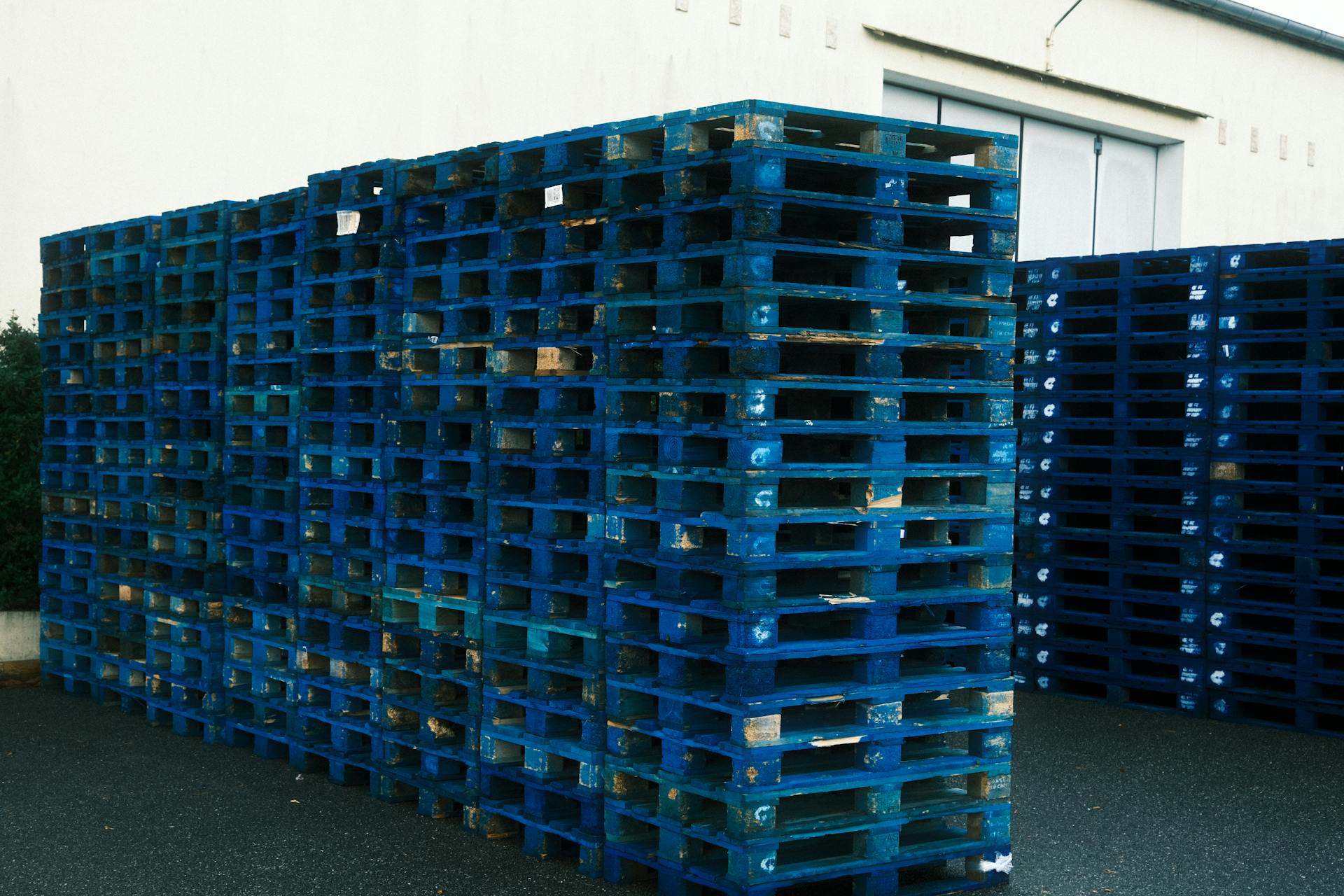
Manual load planning can be time-consuming and prone to errors, which is why more and more companies are using tools to support this process. One of them is a pallet loading calculator, which allows you to quickly and accurately plan the layout of cargo in vehicles or containers.
Using a pallet loading calculator can help you optimize cargo space in general cargo transport, which is extremely important. Maximizing the use of the entire container area or consolidating shipments provides the opportunity to offer lower rates to customers, while maintaining transport safety.
You can also use load planning systems available on the market to optimize loading space. This can help you save on pallet shipments by reducing the number of shipments and increasing the use of available space.
Standard pallet dimensions are 48" x 40" (roughly 4'x3.33'), 42" x 42", and 48" x 48". More than 30% of pallets produced in the U.S. each year are GMA pallets, with the next most common being 42” x 42” and 48” x 48” respectively.
Here are some standard pallet sizes:
By using a pallet loading calculator and optimizing your pallet sizes, you can save time and reduce errors in your load planning process. This can lead to cost savings and improved efficiency in your logistics operations.
Banding and Stretch Wrapping
Carriers often prefer palletized loads to help maximize space inside the trailer. This makes the shipping process more convenient for both parties.
To secure your items on a pallet, you'll need to use bands or shrink wrap. See what it takes to properly secure your items on a pallet with bands or shrink wrap.
Make at least five full wraps around the entire shipment and pallet with shrink wrap, ensuring that the finished shipment and pallet feels like one solid piece. This provides extra stability and protection during transit.
Bands or shrink wrap can be used to secure items on a pallet, but it's essential to use the right amount to avoid damaging the goods or the pallet.
Understanding and Choosing
Choosing the right cargo pallet is crucial for safe and efficient shipping. There are several types of pallets, with names based on their construction, and the most common ones include wood, plastic, and metal pallets.
Wood pallets are the most commonly used pallet for freight-shipping purposes, making up the vast majority of pallet types used. They're inexpensive, easy to recycle/replace, and have endless use cases.
To choose the right pallet, consider the kind of cargo you ship. Every type of cargo needs a different pallet or container, and some may require special protection from damage. For example, hazardous or high-value cargo has special needs.
The size and weight of your cargo are also crucial considerations. The size and weight will decide what pallet to use for safe and efficient handling. Here's a brief overview of the most common pallet types:
Ultimately, understanding the use case for metal, plastic, and wood pallets will help you choose the right one for your shipping needs.
Understanding
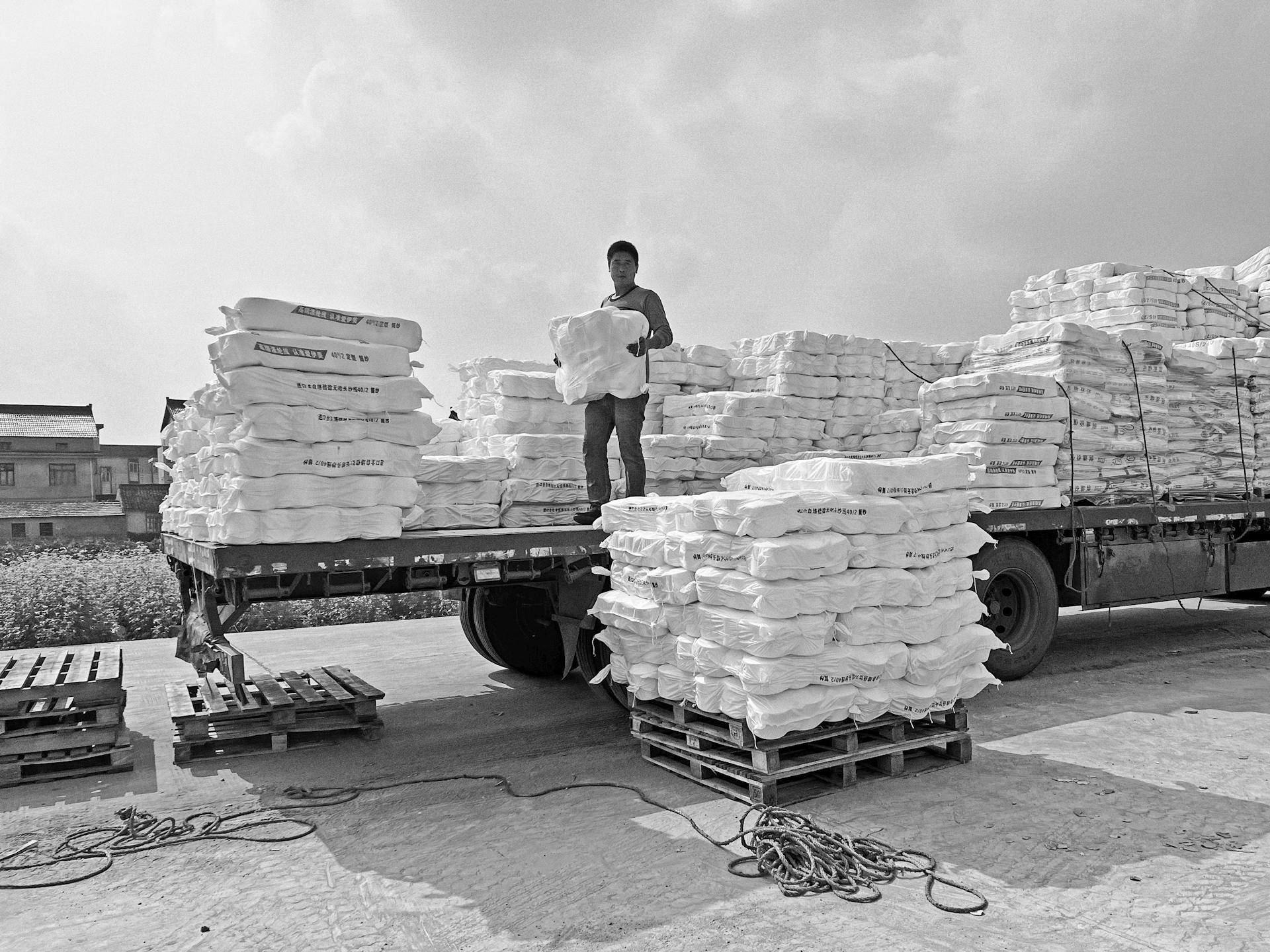
There are several types of pallets, with names based on their construction.
The type of cargo you ship is a crucial factor in choosing the right pallet. Every type of cargo needs a different pallet or container, so consider the kind of cargo you ship.
The size and weight of your cargo are also important considerations. The size and weight will decide what pallet to use for safe and efficient handling.
The destination of your cargo is another factor to consider. Certain airports and airlines have restrictions based on the pallet used, so make sure to check the destination.
The budget is also a consideration when choosing a pallet. The prices vary based on the pallet chosen, so choose one that suits your needs and is budget-friendly.
Here are the five most common pallets seen in shipping:
Understanding the different types of pallets and their uses will help you make an informed decision when choosing the right pallet for your business.
Common Mistakes to Avoid

Don't assume that all products are created equal, just because they're marketed as "eco-friendly" - some may contain toxic chemicals that harm the environment.
Be sure to check the product's materials and manufacturing process to ensure it aligns with your values.
The "recyclable" label can be misleading, as it only means the product can be recycled, not that it will be.
Some products may have a significant carbon footprint due to transportation costs, even if they're made from sustainable materials.
Avoid buying products made from virgin plastics whenever possible, as they contribute to plastic waste and pollution.
Consider the product's lifespan and whether it will need to be replaced frequently, which can lead to more waste and environmental harm.
Container Types and Sizes
There are several types of cargo pallets, including wooden pallets, plastic pallets, and pallets made from other materials.
Wooden pallets are the most common type and are made from wood, usually 48 inches by 40 inches in size.
Plastic pallets are more durable and can withstand harsh environments, but are generally more expensive than wooden pallets.
Block Heading
Block pallets are distinguished by the blocks comprising their middle section, between the top and bottom layers. These blocks are sturdy and located in all four corners and mid-way through each pallet segment.
The blocks in block pallets bolster the pallet's top section, allowing it to support heavier freight than other types of pallets. Block pallets are most commonly made of wood, but this design is also found in some plastic pallets.
Block pallets have a unique design that sets them apart from other types of pallets. They're perfect for handling heavy loads and cargo.
Here are some key characteristics of block pallets:
Standard Sizes
The most common pallet size used in the U.S. is 48 inches by 40 inches, which was standardized by the Grocery Manufacturers of America (GMA) and is now referred to as a CBA pallet.
This size is widely used due to its ease of loading and maneuvering with two to four forklift-entry points.
Here's an interesting read: How Large Are Pallets

In fact, over 30% of pallets produced in the U.S. each year are of this GMA size.
Here are some common pallet sizes you should know:
These sizes are just a few examples of the many standard pallet sizes used in different parts of the world, including Europe, the UK, and for rail freight.
Frequently Asked Questions
What size is a cargo pallet?
A standard cargo pallet measures 48 inches wide by 40 inches long. Its deck boards are 3.5 inches wide and 0.3125 inches thick.
What is pallet cargo?
Pallet cargo refers to goods transported on a pallet for stability during transit. Pallets are used to ship a wide range of items, from building materials to car parts.
What is an air cargo pallet?
An air cargo pallet is a sturdy platform made of heavy-duty plastic or aluminum, designed to securely hold and transport cargo on an aircraft. It typically features a net to keep the load in place during transport.
What are the restrictions on air freight pallets?
Air freight pallets must have a floor-bearing load of at least 100 lbs per square foot and not exceed their rated capacity to ensure safe transportation. Exceeding the rated capacity can lead to serious safety issues and damage to cargo.
Sources
- https://www.atsinc.com/blog/common-pallets-used-for-freight-shipping
- https://www.goodloading.com/en/blog/pallets/air-cargo-pallet-dimensions-and-characteristics/
- https://www.freightquote.com/how-to-ship-freight/standard-pallet-sizes/
- https://www.shiprocket.in/blog/air-cargo-pallets/
- https://www.aeroexpo.online/aeronautic-manufacturer/air-cargo-slave-pallet-5349.html
Featured Images: pexels.com
